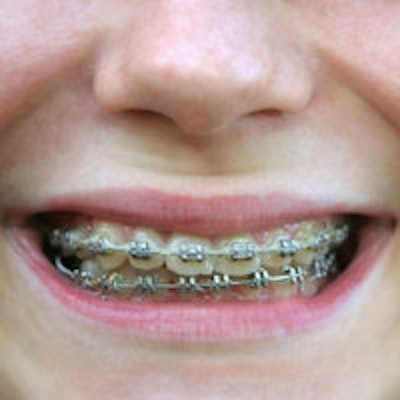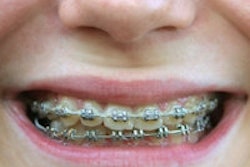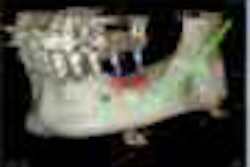
Taking cone-beam CT (CBCT) scans prior to orthodontic diagnosis and treatment planning is warranted for patients with unerupted teeth or severe root resorption, according to a new study in the American Journal of Orthodontics & Dentofacial Orthopedics (May 2013, Vol. 143:5, pp. 665-674).
Researchers from the University of California, Los Angeles (UCLA) wanted to measure the impact of CBCT on orthodontic diagnosis and treatment planning, and determine what patient characteristics might play a role in deciding whether to use CBCT for this application.
"Previous research has shown that lateral cephalograms and panoramic, anterior periapical, and posterior bitewing radiographs provide sufficient information for most orthodontic patients," they wrote. "With the advent of CBCT, it became possible to evaluate the hard and soft tissues of the maxillofacial region in three dimensions and in high spatial detail."
This, in turn, offers the potential to provide orthodontic diagnostics and treatment planning, although it can also increase the cost of treatment and patient exposure to radiation, the researchers noted.
Common clinical characteristics
For this study the researchers selected the records of six patients treated in the orthodontic clinic at UCLA. The records included medical and dental histories; stone study models; full-mouth intraoral and extraoral images; cephalometric, panoramic, and full-mouth series images; and the initial CBCT exam.
"The cases were selected to represent a broad range of clinical characteristics commonly encountered in orthodontic practices," the study authors wrote, including class I, II, and III molar relationships; canine impactions; open bites; cross bites; crowding; and airway and temporomandibular joint (TMJ) problems.
The researchers then invited members of the Pacific Coast Society of Orthodontists and directors of the orthodontic programs at UCLA, University of Southern California, and Loma Linda University to participate in the study. A total of 24 dental professionals agreed to participate; they were mostly men (21), trained at 10 orthodontic programs, with an average of 24 years of experience.
Each participant underwent a two-hour interview in which they were asked to review the six preselected orthodontic cases and provide hypothetical diagnoses and treatment plans. During the interview, they were given each patient's medical and dental histories and shown the study models and various images, with the exception of the CBCT. After describing their diagnostic problem list and their diagnostic degree of certainty for each case, they were then asked if a CBCT scan was warranted as well.
"Regardless of whether they requested a CBCT scan, the participants were asked to evaluate the CBCT examination and note any changes, enhancements, or confirmation to their diagnosis, including reasons for these changes," the study authors wrote.
The study participants were also asked to view preconstructed images of the TMJ, impacted teeth, and teeth with root resorption, and encouraged to create other CBCT cross-sections that would aid in their diagnosis and treatment planning.
Not necessary for all patients
Here are some of the study's findings:
- A total of 64 CBCT scans were ordered. Two participants never ordered a CBCT scan for any of the cases, 16 participants ordered two to four scans, and two participants requested a CBCT scan for all six cases.
- An unerupted tooth was the most frequently cited reason for ordering a scan (64% of orders), followed by root resorption (33%).
- Of the 72 observations on patients with unerupted teeth, a CBCT scan was ordered 39 times when the characteristic was present and only twice when it was not.
- Root resorption was cited as the rationale for ordering a CBCT scan 13 times when the characteristic was present and eight times when it was not.
- Orthodontists in practice for a decade or less ordered significantly fewer CBCT exams than the more experienced orthodontists.
"Our participants requested a CBCT scan during diagnosis and treatment planning substantially more often than they reported using CBCT scans for patients in their private practices (45% versus 12%)," the study authors wrote. This might be due to the higher prevalence of patient problems selected for the test cases than in private practice, they acknowledged.
The study participants changed their diagnosis and treatment plans "significantly more frequently" when an unerupted tooth, root resorption, or severe skeletal discrepancy was present, the researchers noted.
"Of the six patient characteristics cited as reasons for a change to the diagnosis or treatment plan, unerupted tooth, root resorption, and severe skeletal discrepancy were the most frequent," they wrote. "For these characteristics, there were significantly more changes to the diagnoses and treatment plans when the case had the characteristic when compared with cases without the characteristic."
Obtaining a CBCT scan to examine for abnormalities of the TMJ, airway, or crowding did not result in significant changes in the diagnosis or treatment plan, they added.
These findings support obtaining a CBCT scan before orthodontic diagnosis and treatment planning when a patient has an unerupted tooth with delayed eruption or a questionable location, severe root resorption as diagnosed with a periapical or panoramic x-ray, or a severe skeletal discrepancy, the study authors noted.
CBCT scans are not necessary for every patient and should only be ordered "when there is a clear, specific, and clinical justification," they concluded.



















